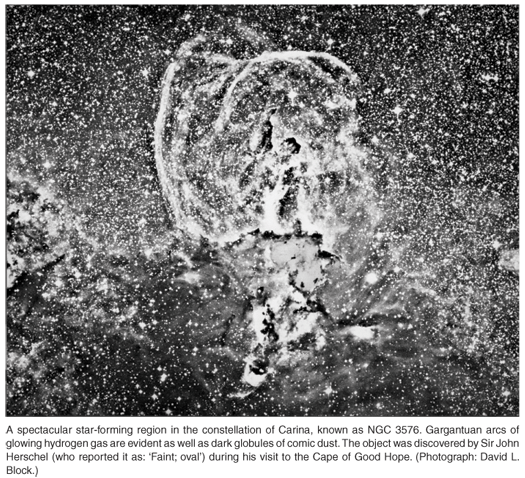Serviços Personalizados
Artigo
Indicadores
Links relacionados
-
 Citado por Google
Citado por Google -
 Similares em Google
Similares em Google
Compartilhar
South African Journal of Science
versão On-line ISSN 1996-7489
versão impressa ISSN 0038-2353
S. Afr. j. sci. vol.104 no.11-12 Pretoria Nov./Dez. 2008
BOOK REVIEWS
Behind the veil
Graham Baker
Shrouds of the Night: Masks of the Milky Way and Our Awesome New View of Galaxies. By David L. Block and Kenneth Freeman. Pp. 441; 204 illustrations. Springer Science+ Business Media, New York; 2008. ISBN 978-0-387-7874-3. US$39.95.
Mankind's long history of observing the night sky is a combination of mystery, wonder and science, of brilliant technology and the most sophisticated theoretical insights, of an appreciation of the smallest and the biggest measures of the known Universe. We are repeatedly surprised by discoveries not anticipated and reassured by confirmation of theoretical predictions. Moreover, the extraordinary diligence and innovation required for recording and understanding the best observational work in astronomy, and the ever-advancing new ways of seeing, can find practical application in our everyday life, although they are generally directed at exotic worlds in deep space.
Many of these points are illustrated in this unusual and beautiful book, which describes a journey in search of an understanding of spiral galaxies. It is the outcome of more than sixty years combined of professional work by the authors. Block is the director of the Anglo American Cosmic Dust Laboratory in the Department of Computational and Applied Mathematics at the University of the Witwatersrand in Johannesburg; Freeman is Duffield Professor of Astronomy at the Australian National Univer- sity. Both have made pioneering contributions to astronomy with eminent collaborators and so are in an excellent position to tell the reader, using stunning images from the latest ground- and space- based telescopes, of what we know about the structures, composition and birthing processes of galaxies, and in what ways they remain a mystery.

The shrouds of the title consist of the massed grains of carbon-based cosmic dust that populate nebulae and galaxies. Their presence—they exist at temperatures of 20 K above absolute zero or even colder—is revealed by near-infrared photography and their formation has even been simulated in the laboratory. Removing them from the earlier visual images of galaxies by photography at the correct wavelength reveals the 'awesome new view' of the cosmic pinwheels. In that way one acquires a completely novel appreciation of the structure of the spirals and how they are populated with stars and dust.
Another theme of the book is the enigmatic dark matter that envelopes galaxies and is believed to represent 90–95% of their total mass but for which there is no recognized evidence. As a further bonus, the reader is treated also to an eloquent introduction, studded with literary allusions and quotations, to some of astronomy's early practitioners and sponsors. No ordinary history this, you will learn about the very earliest beginnings of photography, have proper credit given to those responsible for the milestone discoveries, and even be invited to consider the significance of what it all means.
The authors have been well served by the publisher and designer, who were intelligent enough to gather the informative figure captions in full only after the main text, to allow the remarkable illustrations (of which one is reproduced here) to be printed large enough to fill most of the 300 mm × 22.5 mm landscape page. The book comes at an ideal time to herald the International Year of Astronomy starting next month, and can be ordered from orders@davidblock.com














